Related Research Articles

Cuitláhuac or Cuitláhuac was the 10th Huey Tlatoani (emperor) of the Aztec city of Tenochtitlan for 80 days during the year Two Flint (1520). He is credited with leading the resistance to the Spanish and Tlaxcalteca conquest of the Mexica Empire, following the death of his kinsman Moctezuma II.
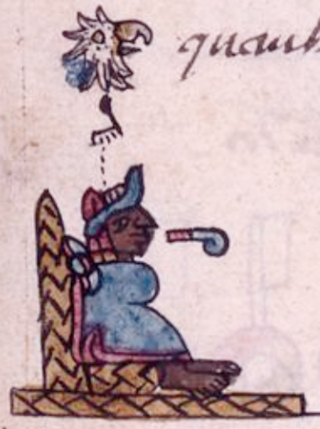
Cuauhtémoc, also known as Cuauhtemotzín, Guatimozín, or Guatémoc, was the Aztec ruler (tlatoani) of Tenochtitlan from 1520 to 1521, making him the last Aztec Emperor. The name Cuauhtemōc means "one who has descended like an eagle", and is commonly rendered in English as "Descending Eagle", as in the moment when an eagle folds its wings and plummets down to strike its prey. This is a name that implies aggressiveness and determination.

Motecuhzoma Xocoyotzin, variant spellings include Moctezuma, Motewksomah, Motecuhzomatzin, Montezuma, Moteuczoma, Motecuhzoma, Motēuczōmah, Muteczuma, and referred to retroactively in European sources as Moctezuma II, was the ninth Emperor of the Aztec Empire, reigning from 1502 or 1503 to 1520. Through his marriage with Queen Tlapalizquixochtzin of Ecatepec, one of his two wives, he was also king consort of that altepetl.

Tenochtitlan, also known as Mexico-Tenochtitlan, was a large Mexican altepetl in what is now the historic center of Mexico City. The exact date of the founding of the city is unclear, but the date 13 March 1325 was chosen in 1925 to celebrate the 600th anniversary of the city. The city was built on an island in what was then Lake Texcoco in the Valley of Mexico. The city was the capital of the expanding Aztec Empire in the 15th century until it was captured by the Spanish in 1521.
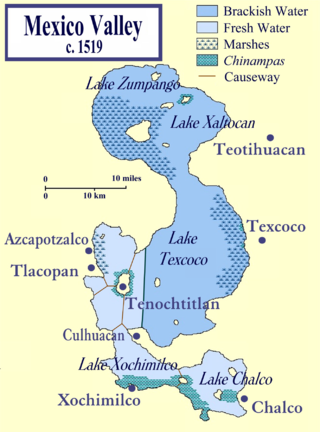
Tetzcoco was a major Acolhua altepetl (city-state) in the central Mexican plateau region of Mesoamerica during the Late Postclassic period of pre-Columbian Mesoamerican chronology. It was situated on the eastern bank of Lake Texcoco in the Valley of Mexico, to the northeast of the Aztec capital, Tenochtitlan. The site of pre-Columbian Tetzcoco is now subsumed by the modern Mexican municipio of Texcoco and its major settlement, the city formally known as Texcoco de Mora. It also lies within the greater metropolitan area of Mexico City.
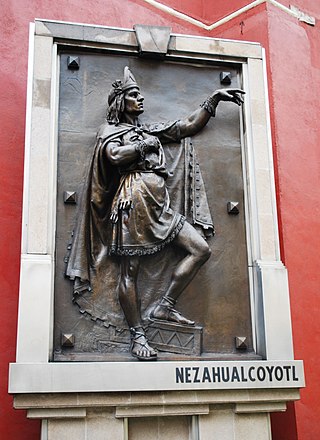
Nezahualcoyotl was a scholar, philosopher (tlamatini), warrior, architect, poet and ruler (tlatoani) of the city-state of Texcoco in pre-Columbian era Mexico. Unlike other high-profile Mexican figures from the century preceding Spanish conquest of the Aztec Empire, Nezahualcoyotl was not fully Mexica; his father's people were the Acolhua, another Nahuan people settled in the eastern part of the Valley of Mexico, on the coast of Lake Texcoco. His mother, however, was the sister of Chimalpopoca, the Mexica king of Tenochtitlan.
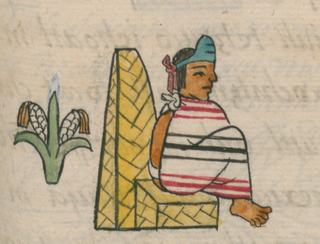
Cacamatzin (1483–1520) was the tlatoani (ruler) of Texcoco, the second most important city of the Aztec Empire.

Acamapichtli was the first Tlatoani, or king, of the Aztecs of Tenochtitlan, and founder of the Aztec imperial dynasty. Chronicles differ as to the dates of his reign: according to the Codex Chimalpahin, he reigned from 1367 to 1387; according to the Codex Aubin, he reigned from 1376 to 1395; and according to the Codex Chimalpopoca, he reigned from 1350 to 1403.
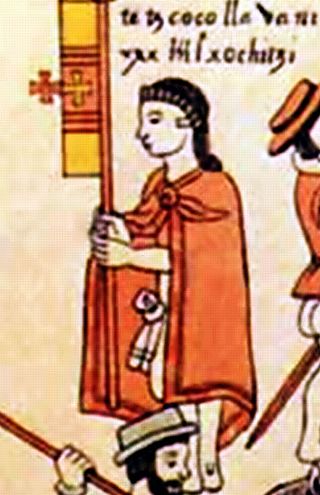
Ixtlilxochitl II was the son of Nezahualpilli, Tlatoani of Texcoco. In 1516 Nezahualpilli died, and the succession was contested by several of his sons, including Cacamatzin and Ixtlilxochitl. The former gained the support of Moctezuma II, Tlatoani of the Aztec Empire. A civil war ensued, and ended in a tripartite division of Tetzcoco, by which one third of the kingdom, with the capital, was awarded to Cacamatzin, the northern part to his brother Ixtlilxochitl, and the third part to another claimant to the throne. Ixtlilxochitl became from that time the enemy of Moctezuma II.

Huitzilihuitl or Huitzilihuitzin was the second Tlatoani or king of Tenochtitlan. According to the Codex Chimalpahin, he reigned from 1390 to 1415, according to the Codex Aubin, he reigned from 1396 to 1417 and according to the Codex Chimalpopoca, he reigned from 1403 to 1417.

The fall of Tenochtitlan, the capital of the Aztec Empire, was an important event in the Spanish conquest of the empire. It occurred in 1521 following extensive manipulation of local factions and exploitation of pre-existing political divisions by Spanish conquistador Hernán Cortés. He was aided by La Malinche, his interpreter and companion, and by other indigenous allies.

Tlacopan, also called Tacuba, was a Tepanec / Mexica altepetl on the western shore of Lake Texcoco. The site is today the neighborhood of Tacuba, in Mexico City.

The Aztec Empire or the Triple Alliance was an alliance of three Nahua city-states: Mexico-Tenochtitlan, Tetzcoco, and Tlacopan. These three city-states ruled that area in and around the Valley of Mexico from 1428 until the combined forces of the Spanish conquistadores and their native allies who ruled under Hernán Cortés defeated them in 1521.
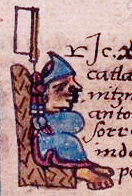
Don Diego de Alvarado Huanitzin was a 16th-century Nahua noble. A grandson of Axayacatl, Nephew of tlatoani Moctezuma II. He was initially the tlatoani (ruler) of Ecatepec before becoming tlatoani of Tenochtitlan, as well as its first governor under the colonial Spanish system of government.

The Aztecs were a Pre-Columbian Mesoamerican people of central Mexico in the 14th, 15th, and 16th centuries. They called themselves Mēxihcah.

The Spanish conquest of the Aztec Empire, also known as the Conquest of Mexico, the Spanish-Aztec War (1519–1521), or the Conquest of Tenochtitlan was one of the primary events in the Spanish colonization of the Americas. There are multiple 16th-century narratives of the events by Spanish conquistadors, their indigenous allies, and the defeated Aztecs. It was not solely a small contingent of Spaniards defeating the Aztec Empire but a coalition of Spanish invaders with tributaries to the Aztecs, and most especially the Aztecs' indigenous enemies and rivals. They combined forces to defeat the Mexica of Tenochtitlan over a two-year period. For the Spanish, Mexico was part of a project of Spanish colonization of the New World after 25 years of permanent Spanish settlement and further exploration in the Caribbean.

Gonzalo de Sandoval was a Spanish conquistador in New Spain (Mexico) and briefly co-governor of the colony while Hernán Cortés was away from the capital.
Don Juan de Guzmán Itztolinqui was a post-Conquest tlatoani (ruler) of the altepetl of Coyoacán in the Valley of Mexico.

Tlatelolco was a pre-Columbian altepetl, or city-state, in the Valley of Mexico. Its inhabitants, known as the Tlatelolca, were part of the Mexica, a Nahuatl-speaking people who arrived in what is now central Mexico in the 13th century. The Mexica settled on an island in Lake Texcoco and founded the altepetl of Mexico-Tenochtitlan on the southern portion of the island. In 1337, a group of dissident Mexica broke away from the Tenochca leadership in Tenochtitlan and founded Mexico-Tlatelolco on the northern portion of the island. Tenochtitlan was closely tied with its sister city, which was largely dependent on the market of Tlatelolco, the most important site of commerce in the area.

Chimalpilli II was a Tlatoani (ruler) of the Nahua altepetl (city-state) Ecatepec, in 16th-century Mesoamerica.
References
- ↑ Diaz, B., 1963, The Conquest of New Spain, London: Penguin Books, ISBN 0140441239
- 1 2 Benton, Bradley (2017). The Lords of Tetzcoco: The Transformation of Indigenous Rule in Postconquest Central Mexico. Cambridge: Cambridge University Press. pp. 31–34. ISBN 978-1-107-19058-0.